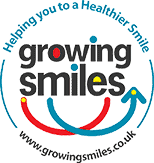Full disclosure can be defined as being completely open and transparent regarding factual information. This can relate to work, law, relationships and various other aspects to daily life.
Here at Growing Smiles, we like to fully disclose as much information relating to oral health as possible, which is why we would like to discuss ‘disclosing’ from a dental perspective.
Plaque biofilm forms on our teeth and soft tissues in our mouth every day. If left there, bacteria in the plaque produce acid from sugars, which can eat away at tooth enamel and cause tooth decay. Other bacteria in the plaque biofilm can irritate gums and lead to gum disease. In order to reduce the risk of dental disease, it is crucial that the plaque biofilm is removed by brushing and flossing daily. This is where disclosing comes in handy – it highlights the plaque biofilm that we can’t see, making it easier to remove.

Disclosing in dentistry is undertaken with the use of a disclosing agent. It works on a similar premise to full disclosure, whereby it provides a clear picture of plaque on the tooth surfaces – where it is and how much there is. This can give an indication to a dental care professional, carer, parent or the person themselves doing the disclosing, how well they manage plaque control and specific areas to focus on when brushing and flossing their teeth.
Disclosing is an excellent tool for teaching (and learning) better oral hygiene and can be done at home or at the dental practice. There are different types of disclosing agents including tablets, mouth rinses, toothpastes, concentrated liquids, gels and pre-loaded pellets.
Why does Growing Smiles recommend disclosing?
- You can see for yourself the areas that you or your child (whoever is disclosing) needs to clean better – where plaque biofilm has accumulated
- Disclosing can be used as a motivational tool to educate or re-educate on oral hygiene and can be fun at the same time!
- It provides a benchmark to measure improvements in toothbrushing (you could take a photo of disclosed teeth and compare it a week or two later)
- It may help you determine if your child is ready to brush their teeth unsupervised or if they still need support
- It’s useful for patients with braces to see where plaque is gathering around brackets and the rest of the orthodontic appliance
Disclosing is simple. If you do it in the dental practice, your dental care practitioner will talk you through the process. If disclosing at home, all you need is a disclosing agent such as TePe Plaque Search tablets or Piksters PlaqGlo toothpaste, a mirror and a toothbrush. A little mouth mirror can be helpful to see behind teeth.

Put the disclosing agent in your mouth (if it’s a tablet chew it well), run your tongue around the teeth as the disclosing agent mixes with saliva, then spit out in the sink. Have a small rinse with water and you will be left with colour on your teeth – this indicates where there is plaque to be cleaned off. Brush your teeth until the colour is no longer visible. You may like to apply lip balm or Vaseline to your lips before disclosing, as sometimes the dye can discolour your lips for a short period of time, particularly if they are dry.
You may like to disclose before or after toothbrushing – depending on what you’d like to find out. If you have thoroughly cleaned your teeth, there should be very little dye that shows up. Sometimes it’s good to evaluate your toothbrushing.
To see the range of disclosing agents available from Growing Smiles click here.

Ok good